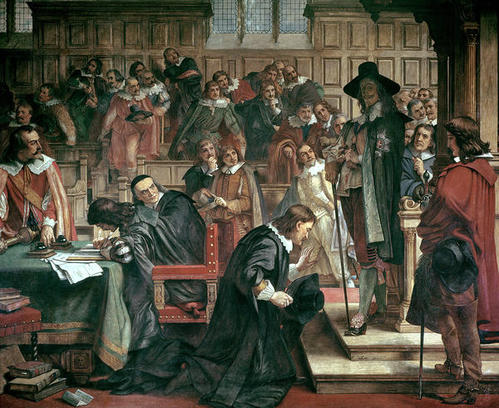The English Civil War and the Glorious Revolution
The English Civil War, Oliver Cromwell’s rule, the Restoration of Charles II, the Glorious Revolution, and how these events shaped the power of Parliament and the monarchy in Britain.
The Beginning of the English Civil War
King Charles I wanted more ceremony in the Church of England and introduced a new Prayer Book. He tried to make the Presbyterian Church in Scotland use it, which caused major unrest.
A Scottish army was formed. Charles needed money for his army but could not raise it without Parliament’s help. In 1640, he called Parliament to ask for funds.
Many in Parliament were Puritans — strict Protestants who preferred simple worship. They disagreed with the king’s religious ideas and reforms. Parliament refused to give him money, even after the Scottish army invaded England.
Meanwhile, a rebellion in Ireland began because Roman Catholics there feared the growing power of the Puritans. Parliament tried to take control of the English army, which would have reduced the king’s power.
Charles reacted by entering the House of Commons to arrest five leaders, but they had been warned and escaped. (No monarch has entered the Commons since.)
Civil war between the king and Parliament began in 1642.
- The king’s supporters were called the Cavaliers.
- Parliament’s supporters were called the Roundheads.

Oliver Cromwell and the English Republic
The king’s army lost the Battles of Marston Moor and Naseby. By 1646, Parliament had won, and Charles I was captured. He refused to cooperate and was executed in 1649.
England then became a republic, known as the Commonwealth, ruled by the army.
Oliver Cromwell, one of its generals, was sent to Ireland to end the rebellion that began in 1641. He used great violence, and his actions still cause debate in Ireland today.
The Scots did not accept the king’s execution. They declared Charles II as king and crowned him in Scotland. He led a Scottish army into England, but Cromwell defeated him at the Battles of Dunbar and Worcester. Charles II escaped and hid in an oak tree before fleeing to Europe.
After these victories, Cromwell became Lord Protector and ruled until 1658. When he died, his son Richard Cromwell took over but could not control the army or government. After 11 years of republican rule, many people wanted stability — and a king again.
The Restoration
In May 1660, Parliament invited Charles II to return from exile in the Netherlands. He became King of England, Wales, Scotland, and Ireland. Charles promised he would not rule alone again and worked with Parliament.
The Church of England became the official church once more. Roman Catholics and Puritans were kept out of power.
During his reign:
- In 1665, a terrible plague killed thousands in London.
- In 1666, the Great Fire of London destroyed much of the city, including St Paul’s Cathedral.
- Sir Christopher Wren designed the new St Paul’s Cathedral.
- Samuel Pepys described these events in his famous diary.
In 1679, the Habeas Corpus Act was passed. This law said that no one could be imprisoned unlawfully and that everyone had a right to a court hearing.
Charles II also encouraged science. The Royal Society, the world’s oldest surviving scientific society, was founded during his reign. Its early members included Sir Edmund Halley, who predicted Halley’s Comet, and Sir Isaac Newton, one of history’s greatest scientists.
Isaac Newton (1643–1727)

A Catholic King
Charles II had no legitimate children. He died in 1685, and his brother became King James II (or James VII in Scotland).
James was Roman Catholic and allowed Catholics to be army officers, which Parliament had banned. He did not cooperate with Parliament and even arrested Church of England bishops.
People feared that he wanted to make England Catholic again. His heirs were two Protestant daughters, but when his wife had a son, it seemed the next monarch would be Catholic.
The Glorious Revolution
James’s elder daughter Mary was married to William of Orange, the Protestant ruler of the Netherlands.
In 1688, leading Protestants invited William to invade England and become king. When he arrived, there was no resistance. James II fled to France, and William became William III (and William II of Scotland) ruling jointly with Mary.
This peaceful change was called the Glorious Revolution. It secured the power of Parliament and ended the danger of a monarch ruling alone.
James tried to reclaim the throne with a French army but was defeated by William at the Battle of the Boyne in 1690. This victory is still celebrated by some in Northern Ireland.
James fled to France, and Irish Catholics lost many rights, including participation in government.
In Scotland, there was a short Jacobite rebellion defeated at Killiecrankie. All Scottish clans had to swear loyalty to William. The MacDonalds of Glencoe were late and were killed — a massacre still remembered with anger.
James’s supporters, known as Jacobites, continued to believe he was the rightful king. Some followed him into exile in France; others supported him secretly.
Key Points
- Charles I’s reforms caused unrest in Scotland and Ireland.
- The English Civil War (1642–1646) divided Cavaliers and Roundheads.
- Charles I was executed; England became a republic under Oliver Cromwell.
- Cromwell ruled as Lord Protector until 1658; his son Richard failed to lead.
- The monarchy was restored in 1660 with Charles II.
- London suffered the 1665 plague and 1666 Great Fire.
- The Habeas Corpus Act (1679) protected against unlawful imprisonment.
- The Royal Society promoted science; Newton made major discoveries.
- James II (1685) tried to promote Catholicism, causing unrest.
- The Glorious Revolution (1688) brought William III and Mary to power.
- The Battle of the Boyne (1690) confirmed William’s rule.
- Jacobites continued to support James II’s cause.